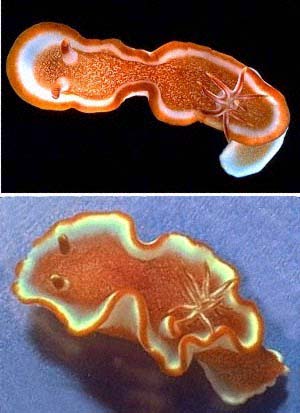
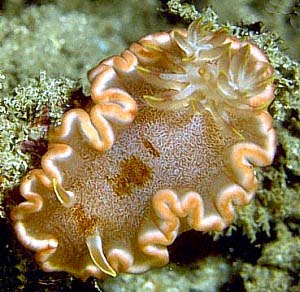
Glossodoris rufomarginata
(Bergh, 1890)
Order: NUDIBRANCHIA
Suborder: DORIDINA
Family: Chromodorididae
DISTRIBUTION
Tropical Indo-West Pacific.
PHOTO
UPPER: Heron Is., Queensland, Australia. August 1985. PHOTO: Bill Rudman.
MIDDLE: 32mm long alive, Mbudya Is, Dar es Salaam, Tanzania, November 1976. PHOTO: Bill Rudman.
LOWER: Bonege, Guadalcanal, Solomon Islands, November 1983. PHOTO: I. Knight.
This species of Glossodoris is characterised externally by the orange-brown speckled pattern on the mantle, the orange-brown mantle border and the broad white submarginal band.
References:
• Rudman, W.B. (1984) The Chromodorididae (Opisthobranchia: Mollusca) of the Indo-West Pacific: a review of the genera. Zoological Journal of the Linnean Society, 81: 115-273.
• Rudman, W.B. (1985) The Chromodorididae (Opisthobranchia: Mollusca) of the Indo-West Pacific: Chromodoris aureomarginata, C. verrieri and C. fidelis colour groups. Zoological Journal of the Linnean Society, 83: 241-299.
• Rudman, W.B. (1986) The Chromodorididae (Opisthobranchia: Mollusca) of the Indo-West Pacific: The genus Glossodoris Ehrenberg (=Casella, H. & A. Adams). Zoological Journal of the Linnean Society, 86(2): 101-184.
Rudman, W.B., 1999 (January 23) Glossodoris rufomarginata (Bergh, 1890). [In] Sea Slug Forum. Australian Museum, Sydney. Available from http://www.seaslugforum.net/find/glosrufo
Related messages
Re: Glossodoris rufomarginata feeding
November 18, 2008
From: Marli Wakeing

Concerning message #22048:
I recently encountered this species for the first time at Lembeh Straight. It was present on a sponge not disimilar in colouration to itself. Perhaps this will add to the information already gathered.
Locality: Lembeh Straight, Sulawesi, 35 feet, Indonesia, Pacific, 30 July 2008, Sand bottom. Length: 4 cm. Photographer: Marli Wakeling.
Cheers,
Marli Wakeling
scubamarli@gmail.com
Wakeling, M., 2008 (Nov 18) Re: Glossodoris rufomarginata feeding . [Message in] Sea Slug Forum. Australian Museum, Sydney. Available from http://www.seaslugforum.net/find/22056
Thanks Marli,
It is certainly not the blackish Semitaspongia which Glossodoris rufomarginata has previously been found associated with. I guess the first step is to see if anyone else has found it with this sponge, as it could of course just be crawling over it, rather than eating it.
There are records on the Forum of Glossodoris sp. 14 associating with a couple of similar looking thorectid sponges, Collospongia sp, Candidaspongia sp. [see #14261, #9600], but we would obviously need to confirm the identity of the sponge and find some evidence that it actually feeds on it. It may turn out to be a dead end, but your photo certainly suggests we should consider more than one species.
Best wishes,
Bill Rudman
Re: Glossodoris rufomarginata feeding [3]
November 17, 2008
From: Scott Johnson


Concerning message #22046:
Hi Bill,
To complete (at least for now) the images of Glossodoris rufomarginata, here are three more shots from the Marshalls. e201-040107 is the largest specimen we've seen, measuring just over 50 mm. e201-040421-k01 is a bit deformed, with both rhinophores extending from the same pocket. e201-k04-070521 shows two quite different-looking specimens that were on the same chunk of sponge. All three photos with this post are of animals that rode the express train-chunks of their prey sponge ripped off the reef on the seaward side and rolled several hundred meters across to come to rest on the lagoon slope.
Locality: Kwajalein Atoll, 8-10m, Marshall Islands, Pacific, 4 September 2001, 21 April 2004, 21 May 2007, coral reef. Length: 20-50mm. Photographer: Scott and Jeanette Johnson.
There are a couple of additional photos on the Marshall Islands nudibranch site at http://www.underwaterkwaj.com/nudi/chromodorids/e201.htm.
Scott
uwkwaj@yahoo.com
Johnson, S., 2008 (Nov 17) Re: Glossodoris rufomarginata feeding [3]. [Message in] Sea Slug Forum. Australian Museum, Sydney. Available from http://www.seaslugforum.net/find/22048
Dear Scott,
If we needed any further evidence of the sponge-nudibranch relationship, the mention on your excellent website that G. rufomarginata is only present when the sponge is present, is pretty good confimration.
Best wishes,
Bill Rudman
Re: Glossodoris rufomarginata feeding [2]
November 17, 2008
From: Scott Johnson
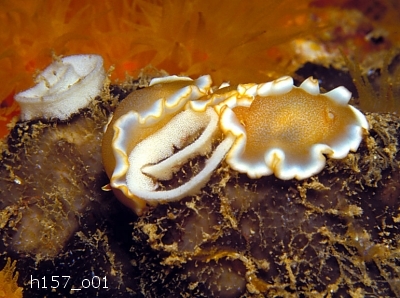
Concerning message #22046:
Hi Bill,
Continuing with the Glossodoris rufomarginata tale, here are three more images of Hawaiian animals on their prey sponge with egg masses. I found that if given the chance, they were more likely to deposit their eggs on bare rock near the sponges, but with 100% of the substrate in the immediate area often covered by sponges, they would also put their eggs directly on their prey sponge.
Locality: Oahu, 5 m, Hawaii, USA, Pacific, 1979, Small caves in basaltic ledges. Length: 10-20 mm. Photographer: Scott Johnson.
Scott
uwkwaj@yahoo.com

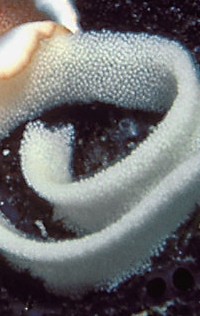
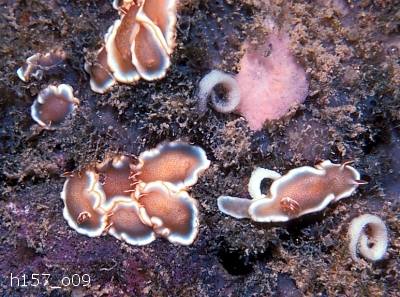
Thanks Scott,
I am glad there is one place in the geographic distribution of Glossodoris rufomaginata that its relationship with its sponge prey is so clear.
Best wishes,
Bill Rudman
Re: Glossodoris rufomarginata feeding [1]
November 17, 2008
From: Scott Johnson
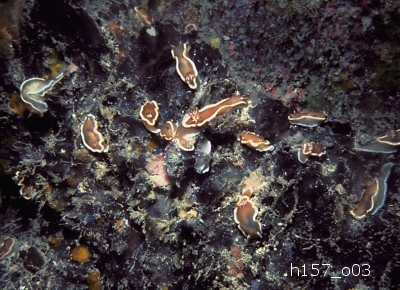
Hi Bill,
After seeing Gary Cobb's recent message on Glossodoris rufomarginata and your response [#22024], I looked through the rest of the messages on that species and saw indeed that there were no photos of its food sponge. Here's one I happen to know a little bit about, since it was the most abundant species in the population study I did for my thesis in Hawaii many years ago. Of course, at the time we knew the nudibranch as Chromolaichma youngbleuthi. This species appears to exclusively eat a dark gray lumpy sponge that lives in small caves and ledges on shallow reefs (about 3-10m depth) and walls in the surge zone. In Hawaii I saw them frequently along lava coastlines where there was some vertical relief, and the gray sponge, identified at that time as a species of Dysidea but now identified as Cacospongia in Hoover, 1999 was abundant. I found the nudibranch to be strongly correlated with the presence of the sponge except in the roughest areas, where apparently the nudibranch could no longer hold on. In calmer water away from the surge zone, the sponge tapered off and disappeared, and so did the nudibranchs. Here in the Marshalls, the species lives out in the ledges of the atoll's seaward reef's groove and spur system, pounded most of the year by surf and rough conditions. It boggles my mind how it can even stay attached under the rougher conditions. The only time I can get in there to look for them is during the rare doldrums that happen to coincide with low surf, and even then the light ocean swell that is almost inevitably present makes it a bouncy dive. Actually, here at Kwajalein I see more specimens on the lagoon sides of some of these reefs, still attached to chunks of their gray sponge prey that have been torn from the rocks in the seaward reef grooves and rolled across the intertidal reef, where they end up on the lagoon slope. The nudibranchs (along with Glossodoris atromarginata, which are common in the same seaward reef grooves) eat up what remains of the sponge they rode across the reef on, then go looking for other colonies that have rolled over. It can be a tough life. Attached are three shots on the prey sponge. The two h157 numbers are from Oahu, Hawaii, and the e201 number from Kwajalein Atoll, Marshall Islands. I'll send some other information and images in separate messages [#22047, #22048 ].
Locality: h157: Oahu, Hawaii , 5 m, Pacific, Hawaii: 1979, on sponges in ledges. Length: 10-25 mm. e201: Kwajalein Atoll, 5 m, Marshall Islands, Pacific, 1 April 2007, on sponges in ledges. Length: 10-25 mm. Photographer: Scott and Jeanette Johnson.
Scott.
uwkwaj@yahoo.com
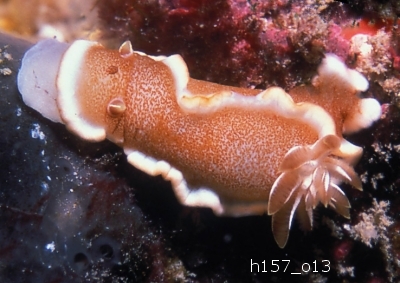
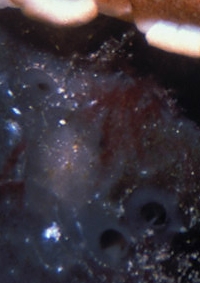

Dear Scott,
Thanks for confirming the identity of the food of G. rufomarginata. As Pat Bergquist and I discussed (Rudman & Bergquist, 2007), this sponge which has been identified as a Dysidea and also as Spongia oceania, can't be either a dysideid or a spongiid because the chemists Terem & Scheuer (1986) identified scalarane molecules from both the nudibranch and the sponge, and these metabolites are unique to thorectid sponges such as Cacospongia and Semitaspongia. Although we would need to examine the fibrous structure of the sponge to be 100% sure, Dr Bergquist, who is an expert on this group of sponges, is sure that the species misidentified as Spongia oceania is a species of Semitaspongia rather than Cacospongia. Because both the sponge and the nudibranch are in taxonomic groups which have undergone major taxonomic rearrangements in recent years it is no wonder that trying to find patterns in food specificity has been so difficult.
Your observation of animals drifting with broken-off pieces of their sponge food is very interesting as if it happens in other species, it could explain finding animals far from their food. When you describe Glossodoris atromarginata also drifting on broken-off sponge, am I right in interpreting that to mean that you have observed them eating the same sponge? Why I ask is that we have interpreted a number of earlier feeding records (Rudman & Bergquist, 2007), to refer to a species of Semitaspongia, including Keoki Stender's message [#11100] reporting it feeding on Spongia oceania in Hawaii. One feature separating sponges of the Spongiidae (such as Spongia) from those of the Thorectidae (such as Semitaspongia) is the arrangement of their fibrous skeleton, which makes spongiids tough and elastic, and thorectids brittle, with a tendency to break off parts of their colony. Your description of parts breaking off certainly suggests a thorectid sponge.
-
Cook S. de C. & Bergquist P. R. 2000. — Two new genera and five new species of the “Cacospongia ” group (Porifera, Demospongiae, Dictyoceratida). Zoosystema 22 (2) : 383-400.
-
Hoover, John P. 1999. Hawai'i's Sea Creatures, A Guide to Hawai'i's Marine Invertebrates. Mutual Publishing, Honolulu. 366pp.
-
Johnson, S. (1983) Distribution of two nudibranch species on a subtidal reef on the western shore of Oahu, Hawaii. The Veliger, 25, 356-364.
-
Rudman, W. B. & Bergquist, P. R. (2007) A Review of feeding specificity in the sponge-feeding Chromodorididae (Nudibranchia: Mollusca). Molluscan Research, 27, 60-88.
-
Terem, B. & Scheuer, P. J. (1986) Scalaradial derivatives from the nudibranch Chromodoris youngbleuthi and the sponge Spongia oceania. Tetrahedron, 42, 4409-4412.
Best wishes,
Bill Rudman
Glossodoris rufomarginata from sthn Queensland
November 14, 2008
From: Gary Cobb
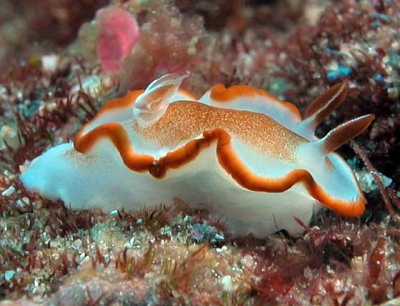
Hi Bill and everyone!
Now that we have our new dive/research vessel it's great to get out to Moreton Island and Flinders Reef. The viz was about 20 m and perfect weather. Turtles were everywhere. On the first dive which was 2 hours David Mullins and I found 16 species of Opisthobranchs and added this one to our list (353).
Locality: Flinders Reef, Moreton Island, 14 m, Queensland, Australia, Pacific Ocean, 07 November 2008, Subtidal. Length: 30 mm. Photographer: Gary Cobb.
We have been searching for this species for quite a while. The Glossodoris rufomarginata we found is pale in regards to it mantle colouring. You can see the colouring on the foot too.
We take a black slate with some weight attached to the bottom to get taxonomic photo under water because there is no collecting in the park.
Thanks Gary
gary@nudibranch.com.au
Cobb, G.C., 2008 (Nov 14) Glossodoris rufomarginata from sthn Queensland. [Message in] Sea Slug Forum. Australian Museum, Sydney. Available from http://www.seaslugforum.net/find/22024
Dear Gary,
Nice find. Taking a piece of black slate with you is a nice idea - and from your results it works well. I suppose, since it's quite uncommon in your area, that there is not much point asking for you to look out for its food sponge - but who knows - this might just be the right time.
Best wishes,
Bill Rudman
Damaged Glossodoris rufomarginata from Bunaken
July 6, 2007
From: Nigel Thomas

Hi,
One of our guests recently took this photo from one of his dives around Bunaken island, North Sulawesi, Indonesia. We cannot find it in any of the fish books, any idea what it is?
Locality: Bunaken Island, 16m, North Sulawesi, Indonesia, Indo-pacific, 15 March 2007, sand slope. Length: 2 inches. Photographer: Lars.
Thanks,
Nigel
diving@twofishdivers.com
Thomas, C., 2007 (Jul 6) Damaged Glossodoris rufomarginata from Bunaken. [Message in] Sea Slug Forum. Australian Museum, Sydney. Available from http://www.seaslugforum.net/find/19741Dear Nigel,
This is Glossodoris rufomarginata. It is quite variable in colour, which is one reason you may not be able identify it from books, but I suspect the other reason is that it appears to be quite damaged. If you look at other photos of it on the Forum you will see that the mantle skirt is normally continuous right around the body while in your animal there are bits missing.
I suspect this is damage from a nibbling fish. Species of this family, the Chromodorididae, store distasteful chemicals in sacs around the mantle edge to deter fish attack. In this case it looks as though a few nibbles around the edge deterred the attacker.
Best wishes,
Bill Rudman
Glossodoris rufomarginata laying egss
January 14, 2006
From: Erwin Kodiat

Hi Bill, happy new year!
This one was taken on the last day of last year in a trip for new year dive.
BTW, is it true all nudibranch has the reproduction organ on the right side?
Locality: Gili Biaha, Amuk Bay, Bali, Indonesia. Depth: 17 metres. Length: 4 cm. 31 December 2005. Wall. Photographer: Erwin Kodiat
Erwin Kodiat
ungu@terong.com
Kodiat, E., 2006 (Jan 14) Glossodoris rufomarginata laying egss. [Message in] Sea Slug Forum. Australian Museum, Sydney. Available from http://www.seaslugforum.net/find/15559Dear Erwin,
Yes the reproductive opening in nudibranchs are on the right side. In your photo, you can't see the egg ribbon emerging but you can see how the back of the foot is used to manipulate the egg ribbon and help in the process of fastening it to the rock in a spiral.
Best wishes,
Bill Rudman
Glossodoris rufomarginata from North Sulawesi
November 10, 2005
From: Erwin Kodiat
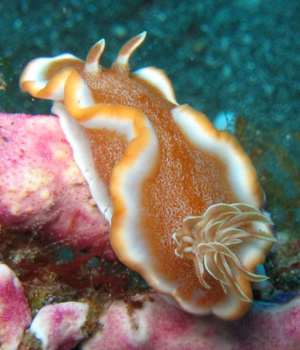
Hi Bill,
Found this Glossodoris rufomarginata at Tanjung Popoh, North Sulawesi.
Locality: Tanjung Popoh, North Sulawesi, Indonesia. 01 November 2005. Sandy bottom. Photographer: Erwin Kodiat
Erwin Kodiat
ungu@terong.com
Kodiat, E., 2005 (Nov 10) Glossodoris rufomarginata from North Sulawesi. [Message in] Sea Slug Forum. Australian Museum, Sydney. Available from http://www.seaslugforum.net/find/15211Thanks Erwin,
Bill Rudman
Unknown Glossodoris from Lembeh
August 22, 2005
From: Fred Wobus
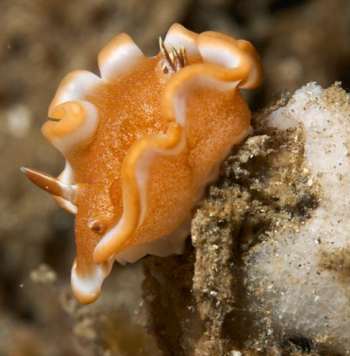
Dear Bill,
Tthe nudi looks like a Glossodoris, but I couldn't match it to any of those in your species list. What is it ?
Locality: Police pier, Lembeh straits, Sulawesi, Indonesia. Depth: about 15 metres.10 June 2005 Photographer: Fred Wobus
Fred Wobus
Wobus, F., 2005 (Aug 22) Unknown Glossodoris from Lembeh. [Message in] Sea Slug Forum. Australian Museum, Sydney. Available from http://www.seaslugforum.net/find/14617Dear Fred,
This is Glossodoris rufomarginata.
Best wishes,
Bill Rudman
Glossodoris rufomarginata on shark
April 22, 2005
From: Kristin Anderson


Dear Bill
Have not come across Glossodoris rufomarginata very often here before and never when I have had a camera.
Locality: Blizzard Ridge, Lighthouse Bay, Ningaloo Reef, Western Australia,
Indian Ocean. Depth: 13 m.Length: approx 6 cm. 28 March 2005. Limestone Coral Reef. Photographer: Kristin Anderson.
This one was obviously on a nudibranch dare from his buddies - that's a big wobbegong shark he is crawling across!
I wasn't game enough to get too close so the size is a guesstimate.
Kristin
kristin@exmouthdiving.com.au
Anderson, KJ, 2005 (Apr 22) Glossodoris rufomarginata on shark. [Message in] Sea Slug Forum. Australian Museum, Sydney. Available from http://www.seaslugforum.net/find/13619Dear Kristin,
I looked at your photos before reading the message, and wondered what it was crawling on. Certainly illustrates the dangers of assuming that what an animal is crawling on is likely to be its food.
Best wishes,
Bill Rudman
Original illustration of Doris picta Pease 1860
March 7, 2005
From: Bill Rudman
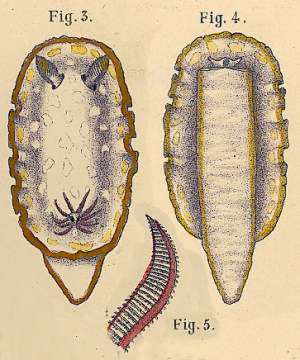
Here is another message concerning the white and purple-spotted chromodorids described from Hawaii by Pease and Garrett. In this one I post the original illustration of Doris picta, Pease, 1860
Doris picta was originally described (Pease, 1860) without an illustration. Bergh (1881: Pl. G, fig 3-5) subsequently published a painting by Andrew Garrett, which we assume was available to Pease.
Here is Pease's description of the external colour:
Colour white, with small irrgular white spots. Obsolete, yellow spots along the margin, which as well as the foot, is bordered with orange. The angular edge of the branchiae edged with carmine. Tentacles tipped with orange. Length 1 inch 6 lines.
The name Doris picta is preoccupied by earlier uses, including Doris picta Schultz, 1836 and Doris picta Kelaart, 1858 which were used for other species. It is difficult to be sure of the identity of Pease's species, but the most likely one is Glossodoris rufomarginata. Pease's mention of and orange border to the foot, orange-tipped rhinophores, and gills edges with carmine, would suggest that species.
-
Pease, W.H. (1860) Descriptions of new species of mollusca from the Sandwich Islands. Proceedings of the Zoological Society of London 28: 18-36.
-
Bergh, L.S.R. (1881) Malacologische Untersuchungen. In: C.G. Semper, Reisen im Archipel der Philippinen, Wissenschaftliche Resultate. Band 2, Supplement 2., 79-128, Pls.G, H, J-L.
Glossodoris rufomarginata from Malaysia
June 22, 2004
From: Paul Tan
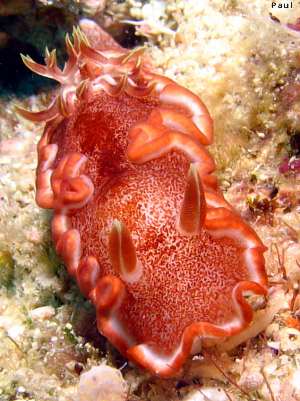
Is this a Glossodoris rufomarginata? The photo was taken at the tip of Captain's Point in Pulau Dayang.
Paul Tan
paul@sg.homeunix.com
Tan, P., 2004 (Jun 22) Glossodoris rufomarginata from Malaysia. [Message in] Sea Slug Forum. Australian Museum, Sydney. Available from http://www.seaslugforum.net/find/12614Dear Paul,
Yes this is Glossodoris rufomarginata. I hope you don't mind me using your message as an example of the type of message I will not be able to accept in future.
I am happy to answer simple identification queries on the Forum - even relatively common species such as G. rufomarginata - because the photos are helping us to build an invaluable record of where these animals live, their colour variation, and when we are very lucky, new information on their biology. But to make it worthwhile I need some reliable locality information to accompany each photo, and a date. In the past, I would have sent you a message asking for more locality details and a date, but keeping track of messages and replies is very time-consuming and cuts down on the time I have available to answer questions etc. With a backlog of almost 1000 messages I need help from contributors to make my job as easy as possible.
We are designing a new 'send message' form which will have boxes for all the essential data I require. As much as I regret it, future messages that don't have the essential information will not be answered. For example, I know that Pulau Dayang is in Malaysia, but without checking I don't know if it is on the west or east coast etc, etc. And since I get messages from all around the world I need sufficient information accompanying the message so that I and other visitors to the Forum don't need an Atlas to make sense of every message.
Best wishes
Bill Rudman
Glossodoris rufomarginata from Japan
December 3, 2003
From: Yukari Sato
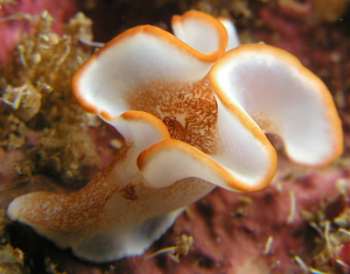
Hello Dr.Rudman,
I have found two animals at Izu, Japan.
I guess these animals are Glossodoris rufomarginata. They were about 10cm apart.
Upper & Lower right: approx. 12mm long. Lower left: approx. 20mm long
Date: 10 Oct 2003
Depth: 3m
Location: Futou, Suruga Bay, west coast of Izu peninsula, Japan
Best regards,
Yukari Sato
yukarisss@hotmail.com
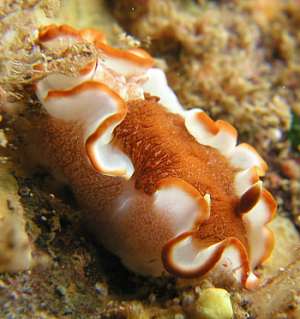
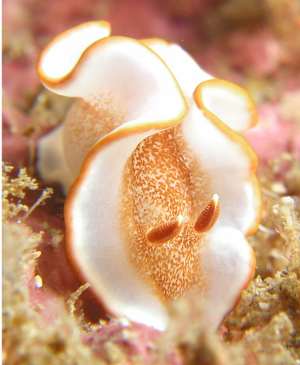
Dear Yukari,
Yes this is Glossodoris rufomarginata
Best wishes
Bill Rudman
Glossodoris rufomarginata from Korea
June 21, 2003
From: Dong Bum Koh
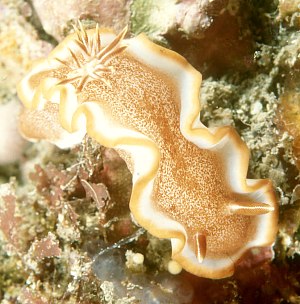
Dear Bill,
Here is a photo of Glossodoris rufomarginata from Sth Korea.
It was taken at Moon islet, Cheju Is, about two years ago in late summer. 23m depth.
I'm happy if its useful in your Forum.
Best regards,
Dong Bum Koh
drkoh@seasee.co.kr
Koh, D.B., 2003 (Jun 21) Glossodoris rufomarginata from Korea. [Message in] Sea Slug Forum. Australian Museum, Sydney. Available from http://www.seaslugforum.net/find/10231Thanks Dong Bum,
Bill Rudman
Glossodoris rufomarginata from Myanmar
March 14, 2003
From: Sarah Heaney

Hi,
Are these nudibranchs a Glossodoris species? The photos were taken in Burma, [Myanmar] Dec 2002.
Regards,
Sarah
sarahlheaney@hotmail.com
Heaney, S., 2003 (Mar 14) Glossodoris rufomarginata from Myanmar. [Message in] Sea Slug Forum. Australian Museum, Sydney. Available from http://www.seaslugforum.net/find/9316Dear Sarah,
Yes these are a Glossodoris species. I am pretty sure they are a colour variation of Glossodoris rufomarginata. This is quite a variable species and in these animals the speckled reddish brown on the mantle is very dense.
Best wishes,
Bill Rudman
Glossodoris rufomarginata from French Polynesia
December 17, 2002
From: Danny Van Belle
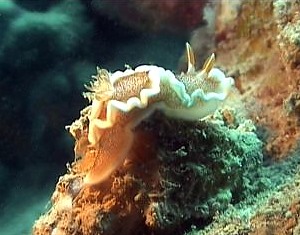
Hi Bill,
I found this one at Raiatea - French Polynesia on the 20 June 2000. Depth 10m at the divesite Nordby wreck. I presume it's a Glossodoris, very similar to Glossodoris poliahu mentioned in the Debelius field guide. Can you help me out?
Best regards,
Danny Van Belle
dannyvb@hotmail.com
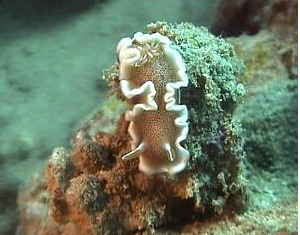
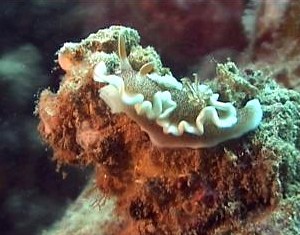
Dear Danny,
This is Glossodoris rufomarginata.
Best wishes,
Bill Rudman
Glossodoris rufomarginata and egg ribbon
July 27, 2002
From: Nishina Masayoshi


Dear Bill,
One more egg ribbon - this one of G. rufomarginata.
Data:
Date: 21 July, 2002
Location: Hachijo Island, Japan
Depth: 10m
Length: 20mm
Photo M. Nishina
Best Regards,
Nishina Masayoshi
nishina@wips.co.jp
Masayoshi, N., 2002 (Jul 27) Glossodoris rufomarginata and egg ribbon. [Message in] Sea Slug Forum. Australian Museum, Sydney. Available from http://www.seaslugforum.net/find/7623Thanks Nishina,
Bill Rudman
Glossodoris rufomarginata from Taiwan
June 17, 2002
From: Todd Garthwaite

Hi Bill,
Here are three shots of what I believe to be Glossodoris rufomarginata.
Site: "Jin-Sha Wan" (["Golden Sand Bay"], N.E. Coast, Taipei County, Taiwan)
Date: 08 June 2002
Time: 09:53am
Depth: 4.8 meters
Temp: 25 degrees C.
Size: Approx. 35+ mm
Stay golden.
Best wishes always,
Todd Garthwaite
(Taipei, Taiwan)
typhoontoddy@yahoo.com


Thanks Todd,
Yes this is G. rufomarginata.
Bill Rudman
Hong Kong Glossodoris rufomarginata
January 22, 2002
From: W. B. Rudman & B. W. Darvell

Here is some information and photos on Glossodoris rufomarginata from Brian Darvell's Hong Kong collections.
The central part of the mantle is closely speckled with reddish-brown and there is a thin band of the same colour around the sinuous mantle edge. The rest of the mantle is white or translucent white. The rhinophore club is reddish brown and the white gills are edged with the same colour. It can grow to 40 mm in length.
PHOTO: AM C139148, 11 April 1983, Site 4.59, Gau Tau (N), Mirs Bay, 5-12 m. Photo: Brian Darvell.
Hong Kong Collection Records:
AM C139148, 11 April 1983, Site 4.59, Gau Tau (N), Mirs Bay, 5-12 m.
Reference:
• Rudman, W.B. & Darvell, B.W. (1990) Opisthobranch molluscs of Hong Kong. Part 1. Goniodorididae, Onchidorididae, Triophidae, Gymnodorididae, Chromodorididae, (Nudibranchia). Asian Marine Biology, 7: 31-79
Best wishes,
Bill Rudman & Brian Darvell
What is this sea slug?
November 2, 2001
From: Fumio Kihara
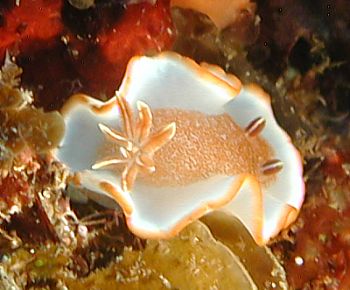
Dear Sir,
In August, I went to Ohshima which is an island in Sagami Bay near Tokyo. While there, our instructor found one sea slug.
It seems similar to Ardeadoris egretta. Its main color is white, but the center of body is brown. And the gills is brown too. The size is about, may be 4cm. Although we search for it in Japanese sea slug books, we could not find its name. We would like to know what it was.
Sorry, on this site, there is too many datas and it is too hard to see all of it.
I have sent a photo of it. I would like to ask you that if you know the name of this sea slug.
Best Regards,
Fumio Kihara
Tokyo, Japan
fumio.kihara@marconi.com
Kihara, F., 2001 (Nov 2) What is this sea slug?. [Message in] Sea Slug Forum. Australian Museum, Sydney. Available from http://www.seaslugforum.net/find/5600Dear Fumio,
This is Glossodoris rufomarginata. It is a tropical species and does not seem to be that common in Japan. It is interesting that animals from China and Japan seem to have a very wide white region on the mantle. The species has quite a variable colour pattern throughout its geographical range.
best wishes,
Bill Rudman.
Glossodoris rufomarginata from Japan
September 8, 2001
From: Toshihiro Horiuchi
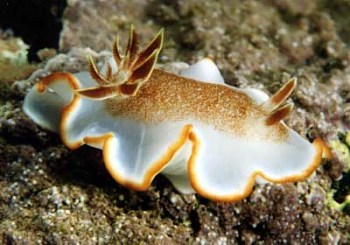
Dear Bill,
I found this animal at Arasaki, Miura Peninsula, Japan. It had adhered to the sponge on a rock with a depth of 0.5m. Water temperature is 25 degrees and a size is about 20mm.
Mr.Satoru Hori who is my friend also by chance had found the same spacies in Miura Peninsula. I looked looked in the seaslug guide books which I own, and on Internet sites, but was unable to find the same species. I think it is perhaps a species of Chromodorididae. Could you help me to identify this?
Best regards,
Toshihiro Horiuchi
YRB00514@nifty.ne.jp
Horiuchi, T., 2001 (Sep 8) Glossodoris rufomarginata from Japan. [Message in] Sea Slug Forum. Australian Museum, Sydney. Available from http://www.seaslugforum.net/find/5220Dear Toshihiro,
This is a colour form of Glossodoris rufomarginata. As you will see on the Forum it is quite variable in colour. If by chance you photographed it on the sponge on which you found it, it would be nice to have a photo of it with the sponge as it might give us a clue to its food.
Best wishes,
Bill Rudman
Glossodoris rufomarginata from the Solomons
February 10, 2001
From: Bruce Potter
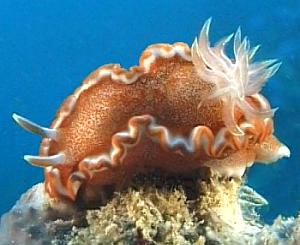
Bill,
I found this very pretty Glossodoris rufomarginatus yesterday. In the past I have found several, and they have all had dark gills to match the body colour. This one had nearly white gills. It was about 25mm long, found at 9m on rubble, just on the outskirts of Honiara, Solomon Islands.
Regards
Bruce Potter.
bruce.potter@adventist.org.sb
Potter, B., 2001 (Feb 10) Glossodoris rufomarginata from the Solomons. [Message in] Sea Slug Forum. Australian Museum, Sydney. Available from http://www.seaslugforum.net/find/3718Thanks Bruce,
Bill Rudman
Glossodoris rufomarginata from Philippines
January 23, 1999
From: Erwin Koehler

Bill,
Here is Glossodoris rufomarginata (Bergh, 1890), Sara's Place, Negros Is.,
Philippines, Nov. 1998.
Erwin
E.Koehler@deutschepost.de
Koehler, E., 1999 (Jan 23) Glossodoris rufomarginata from Philippines. [Message in] Sea Slug Forum. Australian Museum, Sydney. Available from http://www.seaslugforum.net/find/501